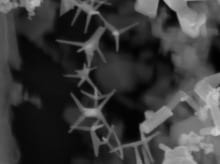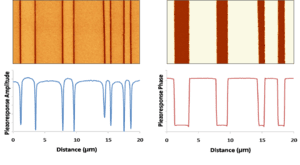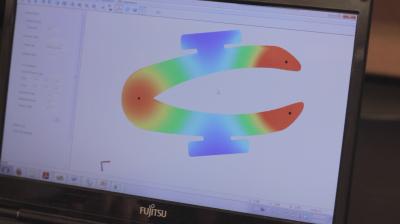
UV-sensors from the oven
Placed in fire detectors and water treatment units UV-sensors can save lives; also in many areas of industry and environment the demand for these devices is rising steadily. Scientists of Kiel University have been able to ”bake” nanostructures within seconds, in order to fabricate very fast UV-sensors. This new technique totally diminishes the need to use sophisticated equipments and toxic chemicals. It will therefore be highly interesting for companies. The scientists have published their results today (November 19) in Advanced Materials, a very renowned scientific magazine.
When building a sensor device from nanostructures, one of the biggest challenges is how to interconnect them into electrical contacts in chips because of their extremely small dimensions in nanoscale range, says Dawit Gedamu, the first author of the paper. Most of the existing synthesis methods, such as Chemical Vapour Deposition or Vapor-Liquid-Solid (VLS) growth allow synthesis of different nanostructures only under specific conditions. For instance, the presence of catalytic particles, particular substrates, complex temperature, atmospheric conditions and many more factors must be met. Furthermore, to integrate the synthesized nanostructures with these techniques in the chips requires another very sophisticated step. There are silicon or gallium nitride based UV detectors already available in the market but they lack a certain level of selectivity and also they cannot function in harsh environments. High production costs, multistep processes and the requirement of specific operating conditions limit the field of application for these sensors.
“Extremely promising” for various applications are the sensors that are based on zinc oxide, says Dr. Yogendra Kumar Mishra, scientific assistant with the work group “Functional Nanomaterials” at Kiel University and main author of the study. “Nanostructures made from zinc oxide are highly interesting for multifunctional applications, due to their sensibility to UV light and their electrical and mechanical properties”, says Mishra. Also, the material is relatively inexpensive and easy to synthesize. Since up to a certain level zinc is necessary for human organisms, these zinc oxide nano-microstructures could be of potential interest for biomedical engineering.
The scientists have fabricated a network of interconnected zinc oxide nano-tetrapods as a bridge between electrodes on a chip by a new single step flame transport synthesis process: In a simple oven or airbrush gun-type burner it only needs high temperature to convert zinc microparticles into nano-micro tetrapods. This process takes place in normal air environment and the necessary amount of oxygen is regulated by the flame itself. “This burner-flame transport synthesis method allows us to grow the zinc oxide nano-microstructures directly on the chip – and that only takes a few seconds, it is just a matter of driving the chip through the flame while the nano tetrapods assemble themselves onto it!” Mishra is excited to report. The high temperature of the flame ensures contacts of good quality between chip and the nanostructures, which is highly desirable for a better performance of the device.
The result: the sensor produced by the Kiel University scientists reacts to UV light within milliseconds of its exposure. Additionally, it also works in rather rough environments. These simple and inexpensive manufacturing conditions as well as the usage of pure zinc microparticles make this production method at the laboratories at Kiel University highly attractive for manufacturing companies. “We already had regional companies inquiring about our work. It shows that our basic research can be transferred into concrete applications”, Professor Rainer Adelung, head of the research team, explains. The next logical step for the material scientists is therefore to find the ways to produce these nano-tetrapods on a larger scale.
One curious fact: Zinc oxide nanostructures started their career as waste from conventional VLS growth experiments for zinc oxide. One day, Yogendra Mishra examined the crystals that looked like artificial snow under the microscope: “Their particular intertwining structure and their ability to detect light implied an enormous potential”, says the scientist, who was holding a fellowship from the Alexander von Humboldt Foundation while developing the new method in the years following this discovery.
The Latest Google Headlines on:
Nanostructures
[google_news title=”” keyword=”Nanostructures” num_posts=”10″ blurb_length=”0″ show_thumb=”left”]
The Latest Bing News on:
Nanostructures
- Researchers 'unzip' 2D materials with laserson May 8, 2024 at 7:44 am
Researchers used commercially available tabletop lasers to create tiny, atomically sharp nanostructures in samples of a layered 2D material called hexagonal Boron Nitride (hBN). The new nanopatterning ...
- Two Brookhaven Lab scientists named AAAS Fellowson May 7, 2024 at 4:13 pm
The American Association for the Advancement of Science (AAAS) has recognized two staff scientists from the U.S. Department of Energy’s (DOE) Brookhaven National Laboratory with the distinction of ...
- Researchers esearchers 'unzip' 2D materials with laserson May 6, 2024 at 4:59 pm
“Usually, you need a shorter wavelength to make a smaller pattern,” said Chen. “Here, we can create very sharp nanostructures using very long wavelengths. It’s a paradoxical phenomenon.” To explore ...
- Columbia researchers “unzip” 2D materials with laserson May 6, 2024 at 4:59 pm
In a new paper in the journal Science Advances, researchers used commercially available tabletop lasers to create tiny, atomically sharp nanostructures in samples of a layered 2D material called ...
- SkyWater and Lumotive Announce Qualification and Production Start for World’s First Commercially Available Optical Beamforming Chipon May 1, 2024 at 4:05 am
SkyWater Technology (NASDAQ: SKYT), the trusted technology realization partner, and Lumotive, a pioneer in optical semiconductor technology for 3D sensing, announced today that the companies have ...
- New class of spongy materials can self-assemble into precisely controllable structureson April 30, 2024 at 8:02 am
A team of researchers led by the University of Massachusetts Amherst has drawn inspiration from a wide variety of natural geometric motifs—including those of 12-sided dice and potato chips—in order to ...
- Scientists construct sophisticated synthetic system using self-replicating nanostructureson April 29, 2024 at 7:03 am
A research team led by the late Professor Liang Haojun from the Hefei National Laboratory for Physical Sciences at the Microscale of University of Science and Technology of China (USTC) has developed ...
- Scientists learn from caterpillars how to create self-assembling capsules for drug deliveryon April 26, 2024 at 8:00 am
Self-assembling molecules that spontaneously organize themselves to form complex structures are common in nature. For example, the tough outer layer of insects, called the cuticle, is rich in proteins ...
- Phonons in Nanostructureson April 24, 2024 at 5:39 pm
Kim, Sun K. and Daniel, Isaac M. 2003. SOLUTION TO INVERSE HEAT CONDUCTION PROBLEM IN NANOSCALE USING SEQUENTIAL METHOD. Numerical Heat Transfer, Part B: Fundamentals ...
- Researchers create nanostructures for efficient and sustainable degradation of pollutantson April 24, 2024 at 9:01 am
The need for sustainable and environment-friendly solutions has accelerated the global demand for green and renewable technologies. In this regard, semiconductor photocatalysts have emerged as an ...
The Latest Google Headlines on:
Nanostructure production
[google_news title=”” keyword=”Nanostructure production” num_posts=”10″ blurb_length=”0″ show_thumb=”left”]
The Latest Bing News on:
Nanostructure production
- Team describes MXene-supported PtCo bimetallic catalyst for hydrogen evolution in acidic conditionson May 6, 2024 at 12:51 pm
Hydrogen energy is considered a promising solution with high energy density and zero pollution emissions. Currently, hydrogen is mainly derived from fossil fuels, which increases energy consumption ...
- Plastic pollution talks make modest progress but sidestep production curbson April 30, 2024 at 12:05 pm
More than 50 countries supported a proposal by Rwanda and Peru for assessing what a sustainable level for plastic production might look like. Plastic production is on track to triple by 2050 ...
- Taylor Swift’s Songwriting and Production Analyzed: 13 Secrets to Her Chart Successon April 29, 2024 at 5:00 pm
Hit Songs Deconstructed has studied the sonic elements of Swift's Hot 100 top 10s from Fearless through Midnights. “The ideas are my favorite part of everything I do. That moment where you’re ...
- Report: Global wine production worst in 62 years due to 'extreme climate events'on April 27, 2024 at 8:55 am
April 27 (UPI) --Fires, droughts and other conditions commonly associated with a changing global climate greatly contributed to making the world's 2023 wine production the worst in 62 years ...
- Airbus Sticks to Plane-Delivery Goal, Ramps Up A350 Productionon April 25, 2024 at 12:07 pm
This copy is for your personal, non-commercial use only. Distribution and use of this material are governed by our Subscriber Agreement and by copyright law. For non-personal use or to order ...
- Mexico is the 'champion' of fentanyl production, head of country's detective service sayson April 24, 2024 at 3:44 am
The head of Mexico's detective service has acknowledged the country is "the champion" of fentanyl production. Mexico is a major producer of fentanyl and methamphetamine, with cartels sourcing ...
- Russia's Shoigu says tank production is boomingon April 19, 2024 at 2:14 am
Shoigu's ministry published video showing him touring a tank factory in the Siberian city of Omsk and meeting workers, whom he praised for exceeding production targets. "The Omsk plant is ...
- L.A. Production Rebounds After Strike, but Still Well Below Peak Levelson April 18, 2024 at 1:00 pm
Los Angeles film and TV production has begun to rebound from last year’s strikes, but still remains well below pre-strike levels, according to data released Thursday by FilmLA. Total location ...
- US Industrial Production Rises Again on Boost From Manufacturingon April 16, 2024 at 6:44 am
US industrial production rose for a second month in March, boosted by a larger-than-expected increase in factory output as manufacturing shows further signs of stabilizing. The 0.4% increase in ...
- Decent Eurozone Production Figures Are No Break From A Weak Trendon April 16, 2024 at 3:50 am
Eurozone industrial production increased by 0.8% in February after a sharp drop the previous month. This means that the overall trend of declining production continues despite small signs of ...










